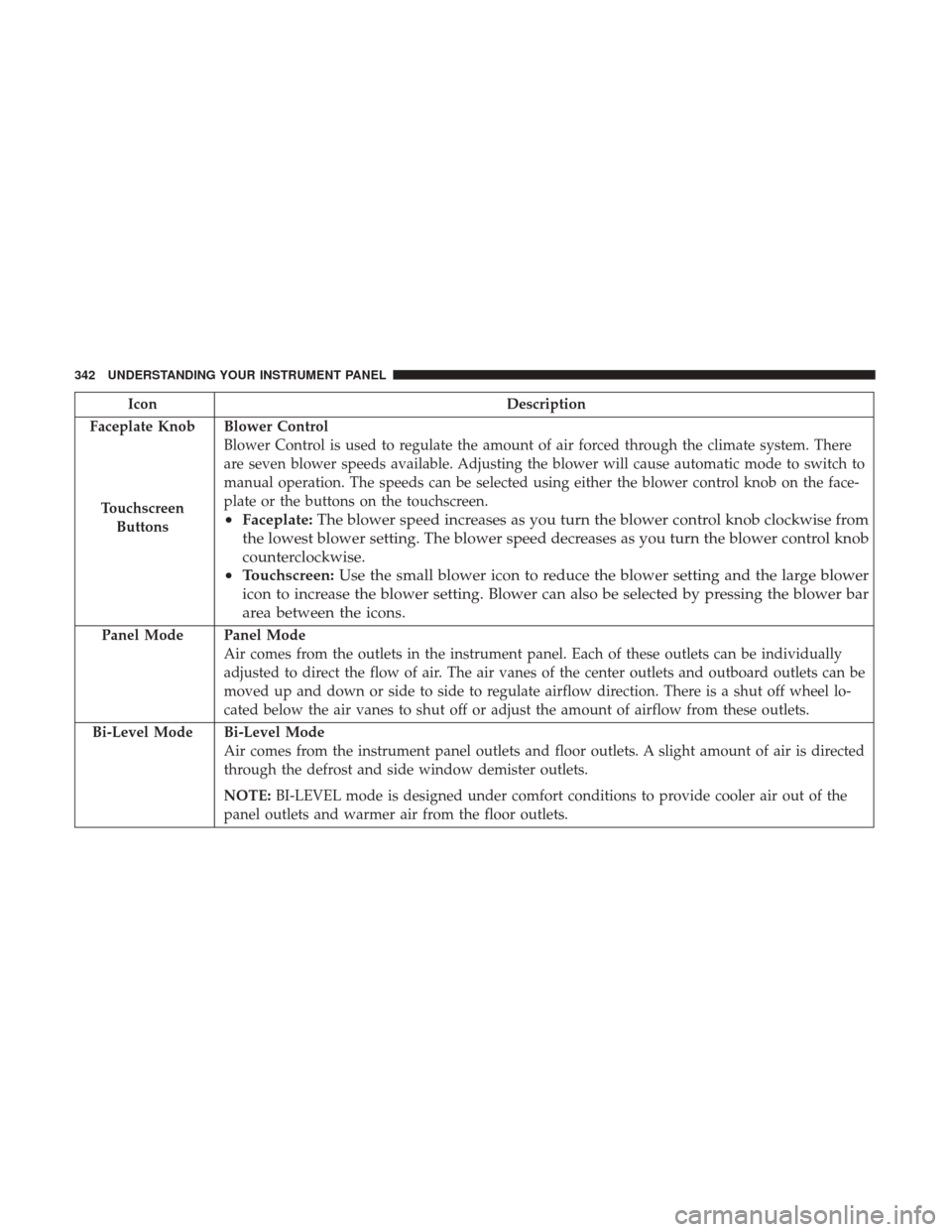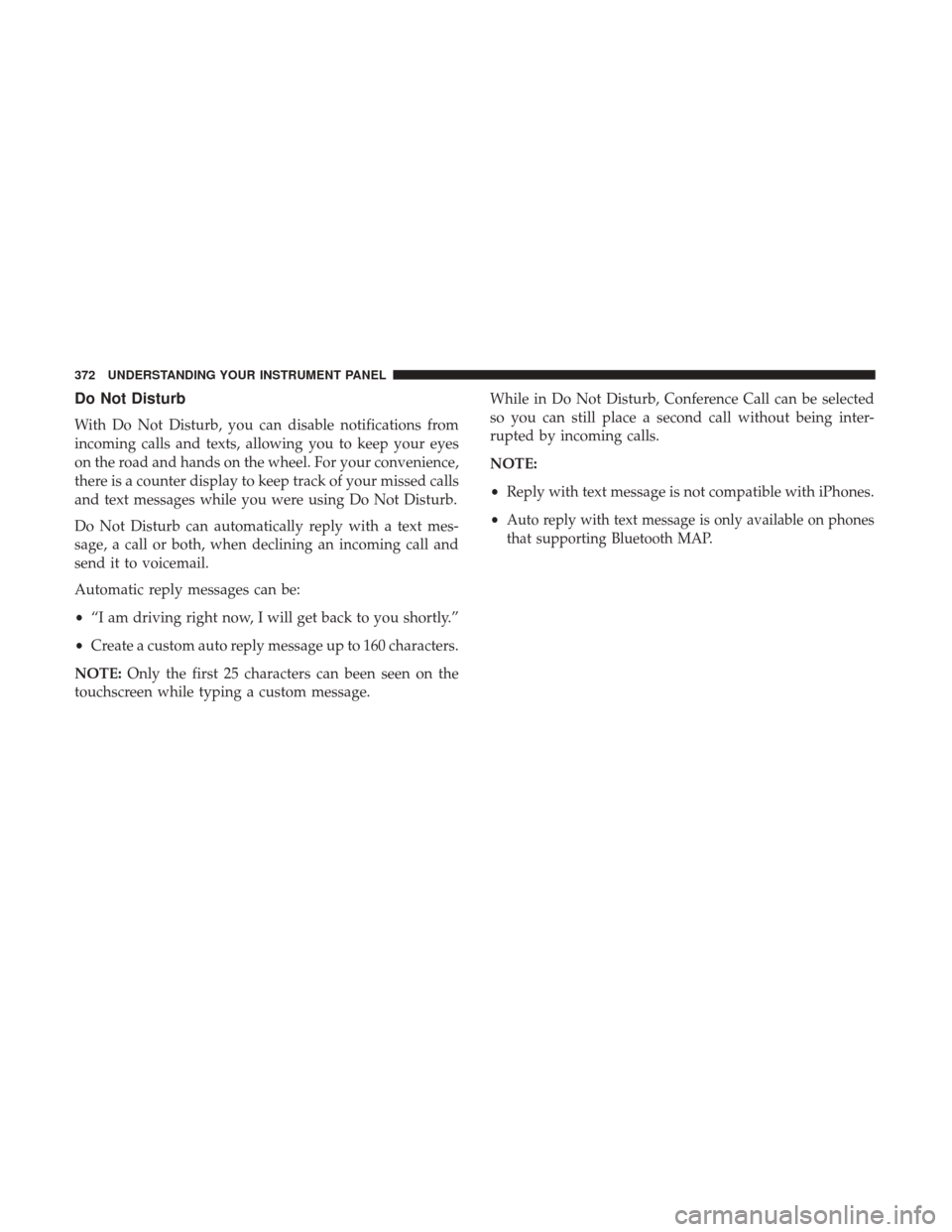Page 344 of 734

IconDescription
Faceplate Knob
Touchscreen Buttons
Blower Control
Blower Control is used to regulate the amount of air forced through the climate system. There
are seven blower speeds available. Adjusting the blower will cause automatic mode to switch to
manual operation. The speeds can be selected using either the blower control knob on the face-
plate or the buttons on the touchscreen.
• Faceplate: The blower speed increases as you turn the blower control knob clockwise from
the lowest blower setting. The blower speed decreases as you turn the blower control knob
counterclockwise.
• Touchscreen: Use the small blower icon to reduce the blower setting and the large blower
icon to increase the blower setting. Blower can also be selected by pressing the blower bar
area between the icons.
Panel ModePanel Mode
Air comes from the outlets in the instrument panel. Each of these outlets can be individually
adjusted to direct the flow of air. The air vanes of the center outlets and outboard outlets can be
moved up and down or side to side to regulate airflow direction. There is a shut off wheel lo-
cated below the air vanes to shut off or adjust the amount of airflow from these outlets.
Bi-Level Mode
Bi-Level Mode
Air comes from the instrument panel outlets and floor outlets. A slight amount of air is directed
through the defrost and side window demister outlets.
NOTE: BI-LEVEL mode is designed under comfort conditions to provide cooler air out of the
panel outlets and warmer air from the floor outlets.
342 UNDERSTANDING YOUR INSTRUMENT PANEL
Page 363 of 734
TIP:Voice Text Reply is not compatible with iPhone, but if
your vehicle is equipped with Siri Eyes Free, you can use
your voice to send a text message.
Climate (8.4/8.4 NAV)
Too hot? Too cold? Adjust vehicle temperatures hands-free
and keep everyone comfortable while you keep moving
ahead. (If vehicle is equipped with climate control.)
Push the VR button
. After the beep, say one of the
following commands:
• Set driver temperature to 70degrees
• Set passenger temperature to 70degrees
TIP: Voice Command for Climate may only be used to
adjust the interior temperature of your vehicle. Voice
Command will not work to adjust the heated seats or
steering wheel if equipped.
Uconnect 8.4/8.4 NAV Climate
4
UNDERSTANDING YOUR INSTRUMENT PANEL 361
Page 371 of 734
Siri Eyes Free — If Equipped
Siri lets you use your voice to send text messages, select
media, place phone calls and much more. Siri uses your
natural language to understand what you mean and will
respond back to confirm your requests. The system is
designed to keep your eyes on the road and your hands on
the wheel by letting Siri help you perform useful tasks.
To enable Siri push and hold, then release the Uconnect
Voice Recognition (VR) button on the steering wheel. After
you hear a double beep, you can ask Siri to play podcasts
and music, get directions, read text messages, and many
other useful requests.
Siri Eyes Free Available
4
UNDERSTANDING YOUR INSTRUMENT PANEL 369
Page 374 of 734

Do Not Disturb
With Do Not Disturb, you can disable notifications from
incoming calls and texts, allowing you to keep your eyes
on the road and hands on the wheel. For your convenience,
there is a counter display to keep track of your missed calls
and text messages while you were using Do Not Disturb.
Do Not Disturb can automatically reply with a text mes-
sage, a call or both, when declining an incoming call and
send it to voicemail.
Automatic reply messages can be:
•“I am driving right now, I will get back to you shortly.”
• Create a custom auto reply message up to 160 characters.
NOTE: Only the first 25 characters can been seen on the
touchscreen while typing a custom message. While in Do Not Disturb, Conference Call can be selected
so you can still place a second call without being inter-
rupted by incoming calls.
NOTE:
•
Reply with text message is not compatible with iPhones.
•
Auto reply with text message is only available on phones
that supporting Bluetooth MAP.
372 UNDERSTANDING YOUR INSTRUMENT PANEL
Page 377 of 734

STARTING AND OPERATING
CONTENTS
�STARTING PROCEDURES .................381
▫ Normal Starting ....................... .381
▫ Automatic Transmission ..................382
▫ Keyless Enter-N-Go — Ignition .............382
▫ Normal Starting ....................... .382
▫ Extreme Cold Weather
(Below –22°F Or �30°C) ..................384
▫ If Engine Fails To Start ..................384
▫ After Starting ......................... .385
� ENGINE BLOCK HEATER — IF EQUIPPED . . . .385
� AUTOMATIC TRANSMISSION ..............386
▫ Key Ignition Park Interlock ................387
▫ Brake/Transmission Shift Interlock System . . . .387 ▫
Eight-Speed Automatic Transmission —
If Equipped ......................... .388
▫ Six-Speed Automatic Transmission —
1500 Models Only (If Equipped) ............395
▫ Six-Speed Automatic Transmission —
2500/3500 Models Only ..................405
� FOUR-WHEEL DRIVE OPERATION —
IF EQUIPPED ......................... .414
▫ Manually Shifted Transfer Case —
If Equipped .......................... .414
▫ Electronically Shifted Transfer Case
(Four-Position Switch) — If Equipped ........417
▫ Electronically Shifted Transfer Case
(Five-Position Switch) — If Equipped ........422
▫ Four-Position Electronically Shifted Transfer
Case (Eight Speed Transmission Only) —
If Equipped ......................... .427
5
Page 380 of 734

▫Trailer Sway Control (TSC) — If Equipped . . . .504
▫ Hill Descent Control (HDC) — If Equipped . . . .505
� TIRE SAFETY INFORMATION ..............508
▫ Tire Markings ........................ .508
▫ Tire Identification Number (TIN) ............511
▫ Tire Terminology And Definitions ...........512
▫ Tire Loading And Tire Pressure ............513
� TIRES — GENERAL INFORMATION .........518
▫ Tire Pressure ......................... .518
▫ Tire Inflation Pressures ..................519
▫ Tire Pressures For High Speed Operation .....520
▫ Radial Ply Tires ....................... .520
▫ Tire Types ........................... .521
▫ Run Flat Tires — If Equipped ..............522
▫ Spare Tires — If Equipped ................523
▫ Tire Spinning ........................ .525
▫ Tread Wear Indicators ...................526 ▫
Life Of Tire .......................... .526
▫ Replacement Tires ..................... .527
� TIRE CHAINS (TRACTION DEVICES) .........528
� TIRE ROTATION RECOMMENDATIONS ......530
▫ Directional Tires — If Equipped .............531
▫ Dual Rear Wheels — If Equipped ...........532
� DEPARTMENT OF TRANSPORTATION
UNIFORM TIRE QUALITY GRADES ..........533
▫ Treadwear ........................... .533
▫ Traction Grades ....................... .534
▫ T
emperature Grades .....................534
� TIRE PRESSURE MONITOR SYSTEM (TPMS) . . .535
▫ Premium System ...................... .536
▫ Tire Pressure Information System (TPIS)
3500 Series Trucks ..................... .539
▫ General Information ....................540
� FUEL REQUIREMENTS ...................541
▫ 3.6L Engine .......................... .541
378 STARTING AND OPERATING
Page 382 of 734
�SNOWPLOW .......................... .568
▫ 1500 Models Only ..................... .568
▫ 2500/3500 Models Only ..................569
� RECREATIONAL TOWING (BEHIND
MOTORHOME, ETC.) ....................572 ▫
Towing This Vehicle Behind Another Vehicle. . . .572
▫ Recreational Towing — Two-Wheel Drive
Models ............................. .573
▫ Recreational Towing — Four-Wheel Drive
Models ............................. .573
380 STARTING AND OPERATING
Page 390 of 734

Eight-Speed Automatic Transmission —
If Equipped
The transmission is controlled using a rotary electronic
gear selector located on the instrument panel. The trans-
mission gear range (PRND) is displayed both above the
gear selector and in the instrument cluster. To select a gear
range, simply rotate the gear selector. You must press the
brake pedal to shift the transmission out of PARK, or to
shift from NEUTRAL into DRIVE or REVERSE, when the
vehicle is stopped or moving at low speeds (refer to
“Brake/Transmission Shift Interlock System” in this sec-
tion). To shift past multiple gear ranges at once (such as
Park to Drive), simply rotate the gear selector to the
appropriate detent. Select the DRIVE range for normal
driving.
The electronically-controlled transmission provides a pre-
cise shift schedule. The transmission electronics are self-
calibrating; therefore, the first few shifts on a new vehicle
may be somewhat abrupt. This is a normal condition, and
precision shifts will develop within a few hundred miles
(kilometers).Only shift from DRIVE to PARK or REVERSE when the
accelerator pedal is released and the vehicle is stopped. Be
sure to keep your foot on the brake pedal when shifting
between these gears.
The transmission gear selector has only PARK, REVERSE,
NEUTRAL, and DRIVE positions. Manual downshifts can
be made using the Electronic Range Select (ERS) shift
control (refer to
�Electronic Range Select (ERS) Operation�
in this section for further information). Pressing the
GEAR-/GEAR+ switches (on the steering wheel) while in
the DRIVE position will select the highest available trans-
mission gear, and will display that gear limit in the
instrument cluster as 1, 2, 3, etc. Some models will display
both the selected gear limit, and the actual current gear,
while in ERS mode.
388 STARTING AND OPERATING